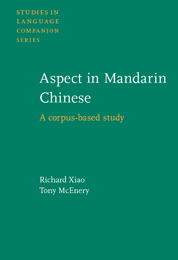
ohn Benjamins Publishing Company
Studies in Language Companion Series 73
2004. x, 303 pp.
Hardbound
1 58811 601 8 / USD 138.00
90 272 3083 8 / EUR 115.00
Chinese, as an aspect language, has played an important role in the development of aspect theory. This book is a systematic and structured exploration of the linguistic devices that Mandarin Chinese employs to express aspectual meanings. The work presented here is the first corpus-based account of aspect in Chinese, encompassing both situation aspect and viewpoint aspect. In using corpus data, the book seeks to achieve a marriage between theory-driven and corpus-based approaches to linguistics. The corpus-based model presented explores aspect at both the semantic and grammatical levels. At the semantic level a two-level model of situation aspect is proposed, which covers both the lexical and sentential levels, thus giving a better account of the compositional nature of situation aspect. At the grammatical level four perfective and four imperfective aspects in Chinese are explored in detail. This exploration corrects many intuition-based misconceptions, and associated misleading conclusions, about aspect in Chinese common in the literature.
Evaluative comments:
“Aspect in Mandarin Chinese makes a very
important contribution to aspect studies. It is the first detailed
account in English of aspect in Chinese; it is based on a balanced
corpus; it recognizes variation among different text types (unlike most
existing work on aspect); it develops and applies a revised version of
Carlota Smith’s two-level model of aspect. The analysis is all the more
valuable for being the product of joint work by a native speaker of
English and a native speaker of Chinese, not to mention the input of
researchers at the Chinese Academy of Sciences. Scholars interested in
aspect in general or in aspect in Chinese or in comparing and
contrasting aspect in Chinese and English will find this book an
essential long-term research tool. I will certainly be using it as soon
as it is published.”
Professor Jim Miller, University of Auckland
“In Aspect in Mandarin Chinese, Richard Xiao and
Tony McEnery achieve a detailed and insightful analysis of verbal aspect
in Chinese, based on a new and powerful two-level model of aspect.
Taking as its starting point the theory of Carlota Smith (1991, 1997),
their model, clearly and subtly developed, shows undoubted advances over
previous treatments of aspect. Of particular importance is the
distinction between viewpoint aspect (which is essentially grammatical)
and situation aspect (which is essentially semantic, to be analysed at
lexical or sentential level). One of the book's particular strengths
lies in its successful combination of theoretical depth with a
corpus-based methodology. The authors’ use of corpora of both Chinese
and English incorporates also the use of a parallel corpus of both
source texts and their translations. The corpus data provide them with a
means to confirm the validity of their model across language boundaries,
and to show the benefit of both theory and data in the contrastive
analyses of the two languages. This book brings new clarity and rigour
to the study of aspect, and so advances an important area of grammatical
research which has previously suffered from confusing or inadequate
formulations.”
Professor Geoffrey N. Leech, Lancaster University
Table of Contents
Preface
Abbreviations and symbols
Chapter 1 Introduction
1.1. What is aspect and why study aspect in Chinese?
1.2. Previous research on aspect in Chinese
1.3. Studying aspect: intuition vs. corpus-based approaches
1.4. The theoretical framework and an overview of this book
Chapter 2 Two-component aspect theory
2.1. Definitional issues
2.2. The two-component aspect model
2.3. Situation aspect: what to classify
2.4. Viewpoint aspect: the perfective/imperfective dichotomy
2.5. Aspect: two components, two levels
Chapter 3 Situation aspect
3.1. Previous studies of situation aspect
3.2. The classification system for situation aspect
3.3. The lexical level: verb classes redefined
3.4. The rules for the three-level interaction at the sentential level
3.5. Sentential level: situation types
Chapter 4 The perfective aspects in Chinese
4.1. The actual aspect: -le
4.2. The experiential aspect: -guo
4.3. The delimitative aspect: verb reduplication
4.4. The completive aspect: RVCs
Chapter 5 The imperfective aspects in Chinese
5.1. The durative aspect: -zhe
5.2. The progressive aspect: zai
5.3. The inceptive aspect: -qilai
5.4. The continuative aspect: -xiaqu
5.5. The zero aspect: covert aspect marking
Chapter 6 Aspect marking in English and Chinese
6.1. Distribution of aspect markers in English and Chinese
6.2. Chinese translation of English aspect markers
Chapter 7 From the study of aspect to contrastive grammar
7.1. Findings of our research
7.2. Extending the aspect model
7.3. A final remark
Bibliography
Index